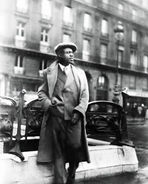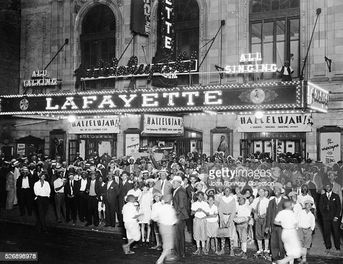

Louis Armstrong
A film exploring the hidden symmetry between mathematics, music, and freedom. Louis Armstrong reimagines the jazz legend’s life through the shared logic of rhythm and ratio — revealing how a man of sound became a master of pattern, and how the language of music can move the world toward harmony.
A story of rhythm, mathematics, and resilience, Louis Armstrong reveals how one man turned jazz into a universal equation for freedom and connection.
Louis Armstrong is not a biopic but an exploration of the invisible architecture shared by mathematics and music — a film about rhythm as ratio, harmony as geometry, and improvisation as the art of solving for the unknown. It traces how Armstrong, through instinct and precision, transformed the abstract logic of sound into an emotional language that redefined both jazz and the idea of freedom.
From the streets of New Orleans to the world stage, Armstrong’s trumpet became an instrument of translation — turning equations into feeling, patterns into protest, and syncopation into an expression of balance and equality. His genius lay in his ability to bridge the two great human pursuits: the search for order and the longing for beauty.
At its core, Louis Armstrong is a meditation on the science of soul — how the same principles that shape the universe echo in a melody, and how one man, through the mathematics of music, taught the world that freedom has a rhythm.
Rhythm and Time Signatures
Jazz rhythm is built on precise mathematical relationships — subdivisions of beats, syncopation, and swing ratios. Armstrong mastered manipulating time itself, stretching or compressing phrases just enough to create tension and release. That subtle timing — playing slightly “behind the beat” — is a rhythmic form of calculus, balancing predictable structure with spontaneous deviation.
STORYTELLING
Improvisation and Pattern
Improvisation is pattern theory in real time. Armstrong didn’t just play random notes; he navigated harmonic structures (like 12-bar blues) using mathematical relationships between scales, chords, and intervals. Each solo was a complex equation balancing repetition, variation, and surprise — the same logic that drives algorithmic design or chaos theory.
Harmony and Frequency
Every note corresponds to a frequency — a number. The way Armstrong bent notes and played with overtones exploited the physics of sound waves. His phrasing was not only emotional but acoustically innovative — a manipulation of waveforms and resonance that parallels the mathematical study of vibration and pattern.
Structure Within Freedom
Jazz, like mathematics, is the art of finding infinite possibility within constraint. Armstrong revolutionized the form by improvising within — and sometimes against — the established framework. That tension between rule and rebellion mirrors how mathematicians and scientists create new knowledge by reimagining the logic that came before.
The Idea
Louis Armstrong’s genius: the discovery that rhythm itself has structure, that freedom can live inside form. The Mathematics of Swing evokes his uncanny ability to bend time, balance chaos, and create harmony from dissonance — an intuitive mastery of the laws that govern both music and the human heart. In Armstrong’s world, every beat is an equation, every solo a proof of symmetry between art and life. The title speaks to what made him more than a musician or ambassador: he was a scientist of feeling, revealing that joy, like music, is a kind of mathematics — precise, infinite, and profoundly human.

The Vision
When numbers learn to Swing reimagines Louis Armstrong not simply as the father of jazz, but as an intuitive mathematician of sound — a man who uncovered the hidden physics of rhythm and turned it into joy. The film opens within his Queens home, where he recorded hundreds of reels of tape — his own private laboratory. Inside these archives of laughter, arguments, and trumpet riffs, the story unfolds as an investigation into the equations he carried in his bones: breath as tempo, heartbeat as meter, time as the variable he could bend. Each improvisation becomes an experiment — a proof that order can exist inside chaos, that freedom can have structure, that emotion itself obeys invisible laws.
From New Orleans to Chicago, Paris to Moscow, Armstrong emerges as a paradox — a working-class genius who translated mathematics into feeling. On stage, he bends time with the precision of a physicist; offstage, he navigates a world divided by race and ideology with the balance of a diplomat. As the United States’ first cultural ambassador during the Cold War, he turns jazz into geometry — a universal language that transcends borders. His horn speaks what politics cannot: symmetry through sound, unity through improvisation. Where others calculate with symbols, he calculates with breath, proving that pattern and soul share the same syntax.
By its final movement, when numbers learn to swing becomes a meditation on the order beneath all art — the bridge between science and emotion. Armstrong’s own recordings form the film’s pulse, a looping rhythm that connects past and present, intellect and instinct. He becomes the mirror image of a mathematician like Emmy Noether: both discovered balance within change, both built worlds from pattern. His legacy endures not only in melody, but in the timeless equation he embodied — that freedom, at its truest, is measured in time, symmetry, and swing.




Impact
When Numbers Learn to Swing will be told with the rhythm and intimacy of Whiplash and the emotional complexity of Ray—a film where music becomes both metaphor and message. Like The Man who knew Infinity, it explores the bridge between intellect and emotion, revealing the quiet beauty of precision and the human cost of genius. it captures the tension between creation and survival, asking what it means to find order within chaos.The film invites audiences to hear jazz not just as sound, but as structure—mathematics made audible.
Armstrong’s life becomes a meditation on the universal architecture of rhythm and ratio, showing how one man’s pursuit of harmony mirrored the world’s struggle toward balance and equality. Beyond the screen, When Numbers Learn to Swing will serve as a catalyst for conversation across art, science, and education. Through workshops, symposia, and community screenings, the project will explore how music and mathematics share a single creative impulse: the desire to understand and to connect. Through its imagery and rhythm, the film explores how inspiration—like jazz—lives between structure and surprise.
Produced by Infinity Films, a division of Infinity Arts Foundation, dedicated to creating cinematic works that illuminate the intersection of art, science, math and the human spirit.























